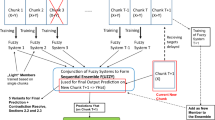Abstract
Evolving fuzzy systems are data-driven fuzzy (rule-based) systems supporting an incremental mode of model adaptation in dynamically changing environments; typically, such models are learned on a continuous stream of data in an online manner. This paper advocates the use of visualization techniques in order to help a user gain insight into the process of model evolution. More specifically, dynamic parallel coordinates, vertical parallel coordinates and rule chains are introduced as novel visualization techniques for the inspection of evolving Takagi–Sugeno–Kang (TSK) fuzzy systems. These techniques are realized in the software tool fuzzy inference system visualizer, the architecture and functionality of which are presented in this work. To show the usefulness of the proposed techniques, we illustrate their application in the context of learning from data streams with temporal concept drift.






















Similar content being viewed by others
Explore related subjects
Discover the latest articles and news from researchers in related subjects, suggested using machine learning.Notes
It would arguably be more correct to solve a linear assignment problem Burkard and Dell’Amico (2009). However, since the computation needs to be repeated at every time step, this is computationally too expensive.
References
Alonso JM, Cordón O, Quirin A, Magdalena L (2011) Analyzing interpretability of fuzzy rule-based systems by means of fuzzy inference-grams. In: Proceedings of world conference on soft computing. San Francisco, pp 181.1–181.8
Angelov P (2002) Evolving rule-based models: a tool for design of flexible adaptive systems. Springer, New York
Angelov P (2004) An approach to on-line identification of Takagi–Sugeno fuzzy models. IEEE Trans Syst Man Cybern Part B Cybern 34(1):484–498
Angelov P, Filev D, Kasabov N (eds) (2010) Evolving intelligent systems: methodology and applications. Wiley, New York
Berthold MR, Hall LO (2003) Visualizing fuzzy points in parallel coordinates. IEEE Trans Fuzzy Syst 11(3):369–374
Burkard RE, Dell’Amico M, Martello S (2009) Assignment problems, SIAM, Philadelphia
Gabriel TR, Thiel K, Berthold MR (2006) Rule visualization based on multi-dimensional scaling. In: Proceedings of IEEE international conference on fuzzy systems. Vanouver, pp 66–71
Gama J (2012) A survey on learning from data streams: current and future trends. Progr Artif Intell 1(1):45–55
Henzgen S, Strickert M, Hüllermeier E (2013) Rule chains for visualizing evolving fuzzy rule-based systems. In: Proceedings of CORES-13, 8th international conference on computer recognition systems. Wroclaw, pp 279–288
Hyvärinen A, Karhunen J, Oja E (2001) Independent component analysis. Adaptive and learning systems for signal processing. Communications and control series. Wiley, New York
Inselberg A (1985) The plane with parallel coordinates. Vis Comput 1(2):69–91
Jolliffe IT (2002) Principal component analysis. Springer, Berlin
Keim DA, Kohlhammer J, Ellis G, Mansmann F (2010) Mastering The information age-solving problems with visual analytics. Eurographics
Lughofer E (2008) FLEXFIS: a robust incremental learning approach for evolving Takagi–Sugeno fuzzy models. IEEE Trans Fuzzy Syst 16(6):1393–1410
Lughofer E, Bouchot JL, Shaker A (2011) On-line elimination of local redundancies in evolving fuzzy systems. Evol Syst 2(3):165–187
Lughofer E, Hüllermeier E (2011) On-line redundancy deletion in evolving fuzzy regression models using a fuzzy inclusion measure. In: Galichet S, Montero J, Mauris G (eds) Proceedings Eusflat-2011, 7th international conference of the European society for fuzzy logic and technology. Aix-les-Bains, France, pp 380–387
Peters G, Bunte K, Strickert M, Biehl M, Villmann T (2012) Visualization of processes in self-learning systems. In: Proceedings of TSOS-12, tenth annual international conference on privacy, security and trust. IEEE Computer Society, Los Alamitos, pp 244–249
Rehm F, Klawonn F, Kruse R (2006) Rule classification visualization of high-dimensional data. In: Proceedings of IPMU-06, 11th international conference on information processing and management of uncertainty in knowledge-based systems, Paris
Shannon CE (1948) A mathematical theory of communication. Bell Syst Tech J 27:379–423
Steele J, Ilinsky N (2010) Beautiful visualization: looking at data through the eyes of experts. Theory in practice series. O'Reilly Media
Zhou H, Yuan X, Qu H, Cui W, Chen B (2008) Visual clustering in parallel coordinates. In: Computer graphics forum, vol 27. Wiley Online Library, pp 1047–1054
Acknowledgments
This project is supported by the German Research Foundation (DFG). The authors also acknowledge financial support by the LOEWE Center for Synthetic Microbiology (SYNMIKRO), Marburg. Moreover, they like to thank Edwin Lughofer for providing the FLEXFIS system.
Author information
Authors and Affiliations
Corresponding author
Rights and permissions
About this article
Cite this article
Henzgen, S., Strickert, M. & Hüllermeier, E. Visualization of evolving fuzzy rule-based systems. Evolving Systems 5, 175–191 (2014). https://doi.org/10.1007/s12530-014-9110-4
Received:
Accepted:
Published:
Issue Date:
DOI: https://doi.org/10.1007/s12530-014-9110-4




